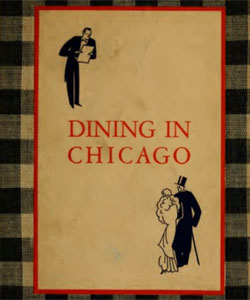 One of the most comprehensive and vivid historical best-ofs about Chicago I’ve ever found is John Drury’s Dining in Chicago—WBEZ did a piece on the former Chicago Daily News reporter earlier this year—a 1931 book with an introduction from none other than Carl Sandburg:
One of the most comprehensive and vivid historical best-ofs about Chicago I’ve ever found is John Drury’s Dining in Chicago—WBEZ did a piece on the former Chicago Daily News reporter earlier this year—a 1931 book with an introduction from none other than Carl Sandburg:
On reading over the text of John Drury’s book one is not merely persuaded that Chicago is a place to stop for more than a sandwich and a cuppa coffee. From page to page he hammers home the evidence that cooking skill and kitchen science has drifted to Chicago from the continents of Asia, Europe, Africa and the archipelagoes of the seven seas.
It’s an interesting read in comparison to the restaurant reviews of today, from a time when Chicago was building a culinary culture, when the city was confident enough to state that it was more than just a sandwich city but not so secure in its food that it couldn’t avoid appealing to outside authority.
Today food critics zero in on the food itself, giving some thought to the service and decor while picking apart each dish like archaeologists. To take a recent example, here’s Jeff Ruby on GT Fish & Oyster:
A clam chowder is chunky with Nueske’s bacon and house-made rosemary oyster crackers, and the spicy tomato sauce with top-notch Prince Edward Island mussels gets the perfect soaker-upper: a long, buttery grilled ciabatta.
Or TOC‘s Julia Kramer in a much-discussed review of The Black Sheep (see the comments for why it’s much-discussed):
Course 6: a bland fillet of redfish, plated atop a disc of pork rillettes, innocent enough until the waiter poured an overwrought bacon-enriched hollandaise-like sauce all over it.
Course 7: a rectangle of overcooked, underseasoned sirloin paired with a chewy scallop—wait, did they really pour milky crème fraîche sauce over this piece of meat? They did.
Despite having worked in features journalism for three Chicago publications with an intense interest in food, I cannot pretend to understand why this—wait, did they really pour milky crème fraîche sauce over this piece of meat?—is surprising. Which is not a criticism of Kramer; despite knowing a reasonable amount about restaurants, even if mostly second-hand, I’m impressed that she can expect enough from her audience to make such an assumption.
Drury, perhaps as a function of the time he was writing, did not make such assumptions. His reviews rarely go beyond making a basic recommendation of specific dishes, with a cursory glance at the ingredients. For example, the Little Bohemia on South Loomis (pictured in the excellent photo galleries I mentioned yesterday):
These dishes, however, are not greatly diflferent from German dishes, but Emil’s roast goose with sauerkraut is something that you’ll like especially. Regular American items are served here also and in a way that does credit to Emil’s cooks, who are all women. And you’ll like the toothsome Bohemian pastries. Emil serves game in season—moose, bear meat and caribou.
And then Drury is immediately on to the culture:
Offering good substantial dishes in an appetizing way, the Little Bohemia caters in a large measure to the sporting element of the city. It receives a heavy "play" during the racing season at Hawthorne, since its location on the west side makes it convenient to motorists on their way out to or returning from the Cicero racetrack. Here, come the prize fight followers after any big fisticuff event at the Chicago Stadium, which is not far away. Gene Tunney dined here at the time he fought Jack Dempsey in Chicago. Newspapermen and city officials are frequenters and it is one of the dining places of Mayor Anton Cermak, who was born in Bohemia. Heads of the commission houses in the South Water Commission Market, located in the nearby "Valley," come here also.
He’s as or more interested in the atmosphere, and very interested in the VIPs who dine at his favorite restaurants—his reviews often contain Homeric catalogs of Chicago society:
And if you want to see some of the noted men of Chicago, men from such landmarks in the vicinity as the Board of Trade, the Stock Exchange, the Federal Building, the Union League Club, the Insurance Exchange Building and the Continental Illinois Bank & Trust Company, come here any day at noon. The late James Patten, the wheat king, ate here, and Arthur Cutten, the present wheat king, comes in often. Here dine such prominent German-Americans as Dr. Otto Schmidt, the historian; Oscar Mayer, the sausage manufacturer; Dr. Hugo Simon, German consul; Dr. Louis B. Schmidt, the noted surgeon; Albert Brietung, the tobacco manufacturer, and Ernest J. Kreutgen, head of the engraving firm. Julius Rosenwald, the philanthropist, dines here frequently, as does James E. Gorman, president of the Rock Island Railroad and Dr. Max Heinus, member of the library board.
Member of the library board? Count me in.
You don’t see this sort of thing much anymore. My colleagues and I were discussing Ian Schrager’s plans to reinvent the legendary Pump Room, which was fabulous enough to inspire Sinatra, the Monkees, and Phil Collins. And save for the Ralph Lauren joint (!) RL, described as "the dining room of choice for Chicago’s local celebrities and society elite" by Chicago‘s Amalie Drury, I couldn’t think of the last time I’d read or heard anyone really talking or writing much about the role of a restaurant or bar in contemporary Chicago, especially in terms like this: "Discretion is key, but certain customers eat at RL day after day, year after year."
I don’t get out much, so I could be wrong. But if this is a reasonably new development, it’s interesting, and something of a democratic triumph: you are what you eat, not where.


